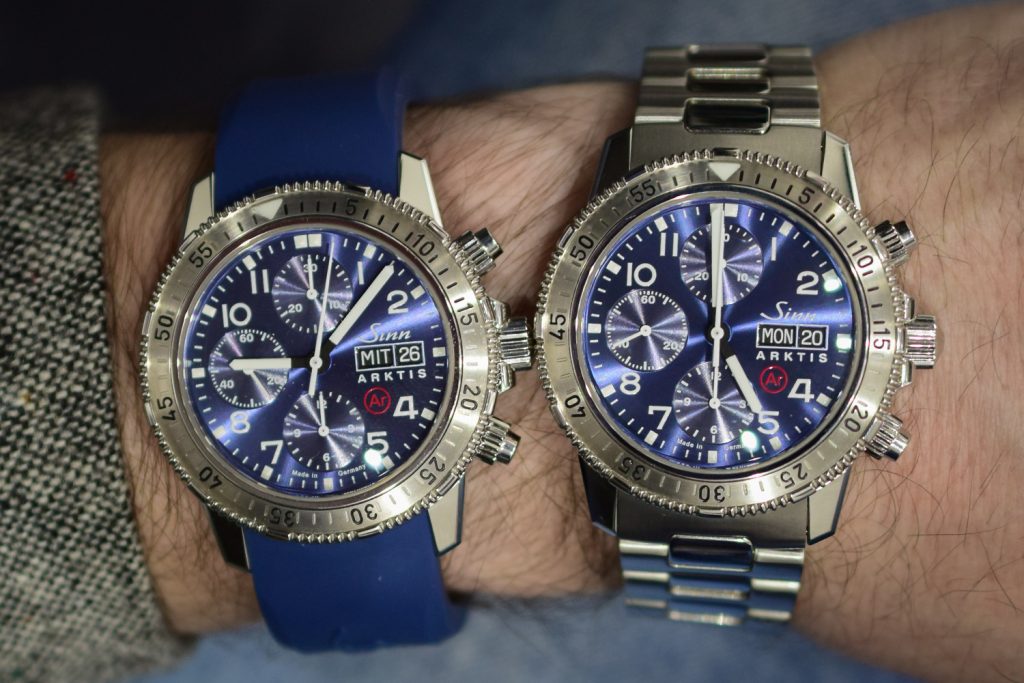Back in 1999, a long time before I was introduced into the world of watches, Sinn produced the first version of 203, which was a chronographChronograph A chronograph complication is a feature in a watch that allows the wearer to measure elapsed time in addition to telling the time. It works by having a separate set of gears and levers, called the chronograph mechanism, which is activated by pressing a button or a pusher. The chronograph mechanism starts and stops the chronograph's second hand, which is usually located on the watch's dial, separate from the regular watch hands. The elapsed time is usually displayed on a sub-dial or a register on the watch's dial. [Learn More] with 300 meter water resistance and functional in extreme cold conditions. Now 20 years later, Sinn has indulged us with the reissue, 206 Arktis.

Similar to the original, it comes with the beautiful arctic blue dial and is water resistant to 300 meters while also functional up to 80C and in -45C. They were able to achieve this with the use of argon gas in the case to allow the watch to remain functional in such extreme situations. Also, the watch incorporates the new D-3 system with the chrono pushers, so even though the pushers are not screwed down, it is more water resistant than before, and it allows the watch to maintain the water resistance at 300 meters (!)

Now I have always lived in the warm climates my entire life so if I have to guess, I am most likely to perish in -45C weather and with 80C temperatures, I’ll end up looking like Dead Pool with severe burns. However, do not worry, the Sinn 206 Arktis will survive you!!

It comes with the brushed H link and also black leather strap as well. Straps can be easily swapped out so you’ll be sure to find your ideal match quite easily. The watch has been beefed up to suit the more contemporary taste of 43mm from the original 41mm, the case stands tall at 17mm, however as you can see from the side profile shot, the lugs taper downwards so the watch should have no problem hugging your wrist.

Another element which I didn’t mention yet, is the above pictured white dot. This being Sinn, that is of course not just a white dot. It is in fact an ingenious feature which would have saved a few of my own watches back in the day had they had this feature.
That white dot is the most important of the three elements of the Ar-Dehumidifying technology which this watch uses (the other two being the aforementioned gas-filling & EDR seals). The capsule is filled with copper sulfate, which is white in a ‘dry’ state. Should humidity or air leak inside the case, the sulfate will absorb the moisture from the air inside the case. The kicker here is that copper sulfate turns increasingly blue as its water content rises. So in case that white turns in any shade of blue – you know you don’t take your watch swimming and instead make a run to your watchmaker to have it serviced! A truly ingenious feature.

Just for fun, we tried a side by side shot of the watch on a radical blue rubber strap and the bracelet. On bracelet it has a lot more wrist presence, much to nobody’s surprise I’m sure. Initially, I would’ve preferred they stayed at 41mm. However, having tried the watch on a 6.5″ wrist, I can confirm Sinn has somehow managed to keep it extremely wearable and the watch doesn’t wear overly big at all. On the smallest of wrists, perhaps put it on a strap as it wears visibly smaller than on the bracelet which adds some visual heft to it.

In addition, Sinn also released a nearly identical watch in black, the 206 St Ar. The only difference is the watch is not durable under extreme temperature but still has the argon filled case and 300 meters of water resistance and all the robustness offered by Sinn’s Ar-technology. Excluding the temperature resistance difference it is identical to the blue version.

More info can be found right here at Sinn Uhren


Awesome write up 😉 and great side by side wrist shot!!!